Bahia Palace - Marrakech
Step into the Bahia Palace in Morocco, a 19th-century architectural jewel in Marrakech. Known for its intricate designs, lush courtyards, and fascinating history, the palace reflects Morocco’s artistry and grandeur. Visitors can explore its stunning marble courtyards, painted ceilings, and vibrant gardens while uncovering the rich heritage of the Bahia Palace in Marrakech.
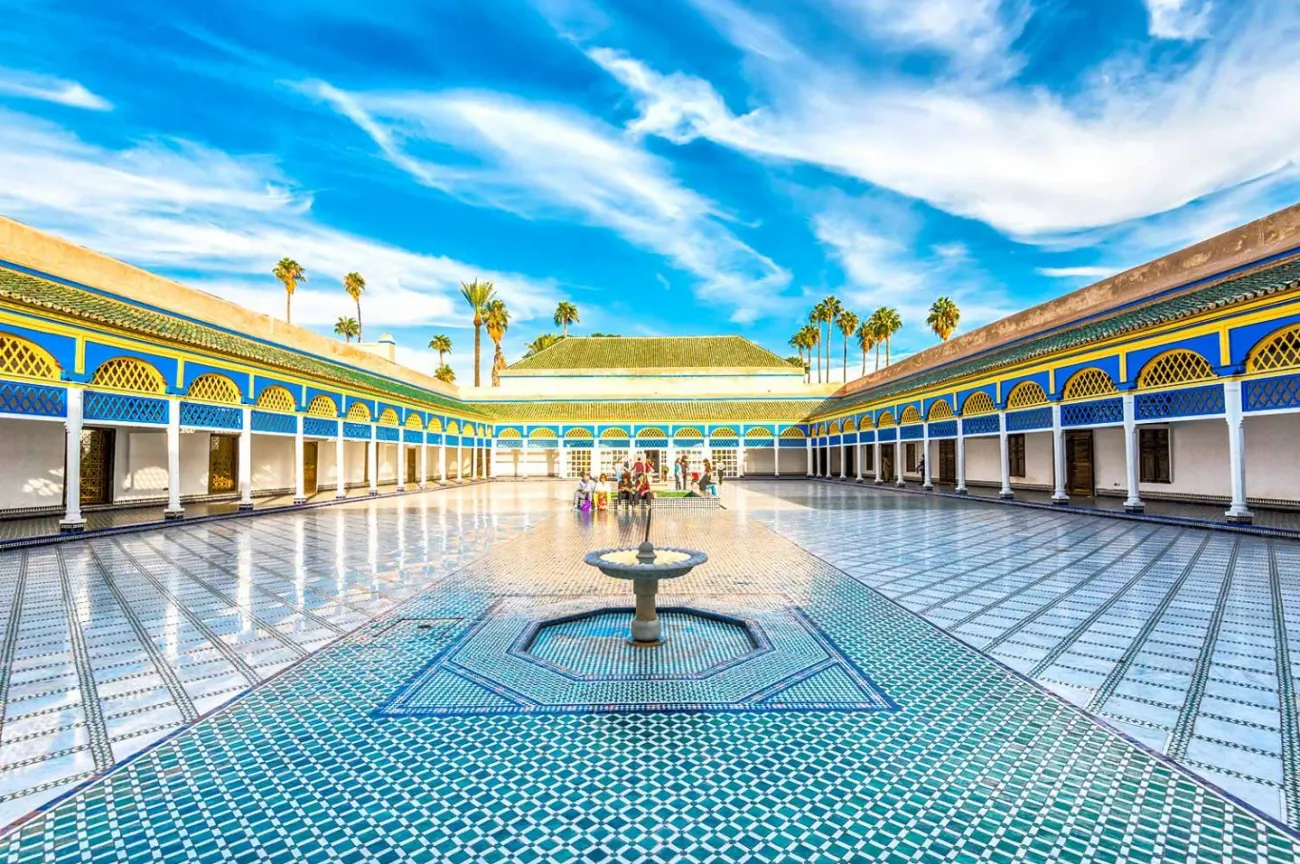
Bahia Palace emerges from the heart of Marrakech as North Africa's most captivating architectural marvel, a testament to 19th-century Moroccan grandeur that continues to astound visitors more than a century after its completion. Constructed across four decades between the 1860s and 1900, this extraordinary palace complex unfolds across eight hectares in an intricate maze of approximately 150 rooms, each space carefully arranged around enchanting courtyards and verdant gardens.
The palace reveals itself selectively to modern explorers, with only selected portions accessible to the public today. Yet these accessible areas present a magnificent 8,000-square-meter showcase of Morocco's finest artisanal traditions, intricate marquetry, elaborate plasterwork, and exquisitely painted wood surfaces that speak to centuries of inherited craftsmanship. Every corridor whispers stories from the Bahia Palace's storied past, particularly within the Grand Courtyard, an imposing space that emerged during the palace's final construction phase between 1896 and 1897. The crown jewel remains the Cour d'Honneur, where 1,500 square meters of pristine Italian Carrara marble creates a breathtaking canvas beneath Morocco's azure sky. This architectural wonder has earned its place as Morocco's premier heritage destination, drawing a remarkable 410,141 visitors during just the first four months of 2019 alone.
A Walk Through the Bahia Palace Morocco
The palace reveals its secrets through a magnificent horseshoe arch doorway, where the cacophony of Marrakech's bustling streets gives way to an oasis of architectural wonder and centuries-old tranquility.
Starting at the entrance gate
The entrance pathway unfolds like a botanical paradise, where towering palms stand sentinel alongside fragrant yuccas, flourishing citrus trees, stately cypresses, and cascading hibiscus adorned with trailing jasmine. Orange blossoms perfume the air with their heady fragrance, marking a profound sensory shift from the medina's vibrant chaos into this regal sanctuary. This verdant corridor provides the perfect introduction to the architectural treasures that lie ahead.
Exploring the Petit Riad
The garden path continues toward a modest courtyard that opens into the Small Riad (Petit Riad), representing one of the palace's later architectural additions. Here, a stunning ceramic fountain commands attention at the center of this square garden courtyard, while ornate galleries and chambers create an elegant perimeter. The surrounding walls showcase extraordinary white plasterwork bearing Quranic inscriptions, each delicate verse carved directly into wet plaster, demonstrating the remarkable precision of master craftsmen from this golden era. These chambers once included Ba Ahmed's Council Chamber (Diwan), the very room where Morocco's Grand Vizier deliberated with his most trusted advisors.
Crossing into the Cour d'Honneur
Continuing eastward through the Small Riad and past a smaller inner courtyard, visitors encounter the palace's most spectacular achievement: the Grand Courtyard (Cour d'Honneur). This monumental space, constructed during the palace's final years between 1896 and 1897, stretches an impressive 50 by 30 meters, its entire surface adorned with gleaming Italian Carrara marble. The courtyard's completion required nearly a decade of meticulous work, surrounded by galleries featuring distinctive bright blue and yellow plasterwork combined with intricate woodwork. From this central hub, approximately 80 chambers once provided accommodation for Ba Ahmed's extensive harem and numerous concubines.
Ending at the Grand Riad
The northern reaches of the Grand Courtyard lead to the Grand Riad, the palace complex's oldest section, completed in 1867 under the direction of Si Moussa, the remarkable former slave who ascended to become one of Sultan Hassan I's most influential advisors. This historic area encompasses a sprawling interior garden where original 19th-century trees continue to flourish. The Grand Riad's salon stands apart for its exceptional decorative elements: carved wood lintels, traditional zouak artistry, and pioneering stained glass details. The Bahia Palace holds the distinction of being North Africa's first structure to feature stained glass as an architectural ornament.
Plan your visit to the Bahia Palace with our Morocco travel packages and uncover the history, beauty, and culture of Marrakech. Book your journey today!
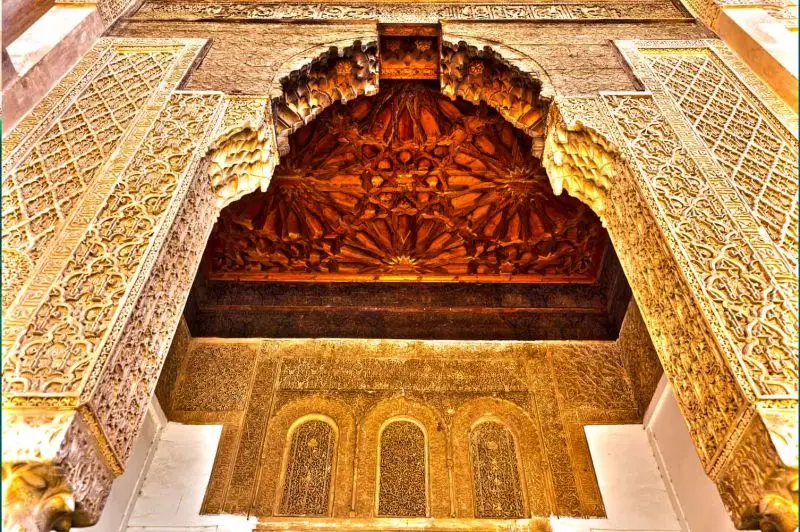
The Story Behind the Walls
The fascinating chronicles of the Bahia Palace trace back to the 1860s, when two remarkable figures orchestrated one of Morocco's most extraordinary tales of ambition and architectural achievement.
Who built the Bahia Palace and why
Si Moussa stands as the original architect of this palatial dream, commissioning its initial construction between 1866 and 1867 during an era when such audacity seemed impossible. His journey from slavery to the prestigious position of Grand Vizier under Sultan Hassan I represents one of history's most compelling narratives of social ascension, and this palace served as his bold declaration of newfound power and influence. The legacy continued through his son, Ba Ahmed (alternatively known as Bou Ahmed), who inherited both the palace and his father's political acumen, dramatically expanding the complex between 1894 and 1900. When Sultan Moulay Hassan died in 1894, Ba Ahmed assumed regency over the teenage Sultan Abdelaziz, positioning himself as Morocco's de facto ruler. During his tenure as Grand Vizier, Ba Ahmed methodically acquired adjacent properties whenever they became available, gradually expanding his palatial domain to accommodate his four wives and twenty-four concubines.
The meaning of 'Bahia' and its legacy
Historical documentation reveals that "Bahia" translates to "brilliance" or "beautiful" from Arabic origins. However, a more intimate story suggests the name honors Ba Ahmed's most cherished wife, Bahia herself. This magnificent structure serves as a window into Morocco's complex past, though its story takes a dramatic turn following Ba Ahmed's death in 1900, when the palace faced systematic plundering by his widows and, reportedly, even the Sultan. Colonial Morocco witnessed the palace's transformation into French administrative quarters, later evolving into a royal residence after independence in 1956, until King Hassan II eventually placed it under the stewardship of Morocco's Ministry of Culture.
How the palace reflects Moroccan elite life
Bahia Palace breaks from the fortress tradition that dominated Moroccan architecture, instead embracing pure luxury and refined pleasure as its guiding principles. Every surface across its expansive 8,000 square meters speaks to the extraordinary wealth and sophisticated tastes of Morocco's ruling class. These powerful viziers orchestrated an ambitious material procurement network, sourcing marble from Meknes quarries, aromatic cedar from Middle Atlas forests, and decorative tiles from Tetouan workshops. Master craftsmen arrived from every corner of the kingdom to create stunning marquetry, elaborate plasterwork featuring Quranic verses, and painted cedarwood ceilings alive with botanical motifs. The palace's 150 chambers, ranging from formal council halls to private apartments and segregated harem quarters, illuminate the intricate hierarchies that governed Morocco's aristocratic society. Remarkably, members of the royal family continue to utilize the palace for special occasions, ensuring its enduring role as a symbol of Moroccan nobility.
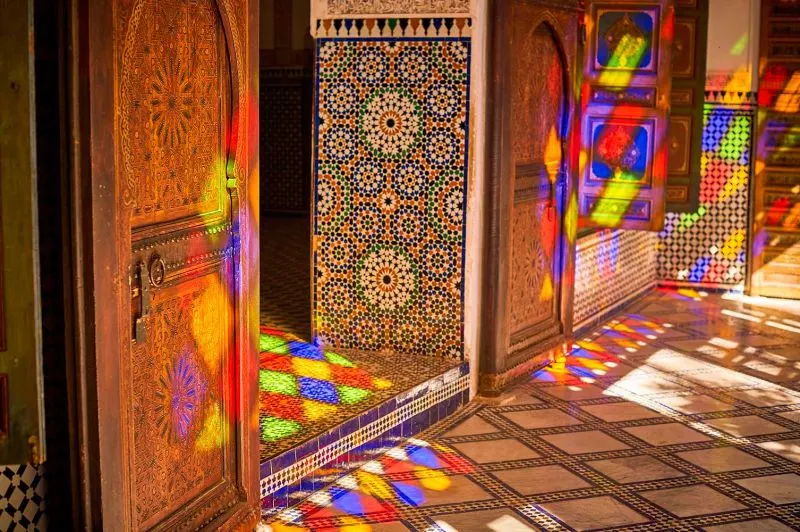
Customize Your Dream Vacation!
Get in touch with our local experts for an unforgettable journey.
Plan Your TripWhat Makes the Bahia Palace Unique
Several distinctive architectural innovations set the Bahia Palace apart from Morocco's other palatial complexes, each decision reflecting both practical considerations and artistic vision that continues to fascinate architectural scholars today.
Use of space and single-level design
The palace's horizontal expanse tells a deeply personal story. Every room, corridor, and courtyard exists on a single level, a deliberate architectural decision prompted by Ba Ahmed's physical limitations, as historical accounts describe him as "stout and obese," making stair climbing particularly challenging. This constraint birthed an ingenious solution that became the palace's defining characteristic. The irregular layout emerges from decades of organic expansion, with new sections added whenever adjacent land became available for purchase, creating a complex that defies conventional palace planning. Visitors today experience this labyrinthine quality as corridors wind unexpectedly, revealing hidden chambers and private alcoves that blur the boundaries between public ceremonial spaces and intimate family quarters.
Integration of gardens and courtyards
Bahia Palace pioneers a revolutionary approach to Moroccan residential architecture where gardens function as living corridors rather than mere ornamental displays. Multiple riad gardens serve as transitional spaces, natural "hallways" that residents must traverse when moving between different wings of the palace. These verdant passages burst with jasmine, roses, citrus trees, and banana plants, creating a sensory journey where the scent of orange blossoms and the sound of fountains accompany daily movement throughout the complex. This design philosophy means that nature becomes woven into the fabric of daily life, where stepping from one room to another requires crossing through carefully cultivated garden spaces.
First use of stained glass in North Africa
Perhaps the palace's most groundbreaking innovation lies in its pioneering use of stained glass, a decorative technique that had never before appeared in North African architecture. These jewel-toned panels transform sunlight into dancing patterns of color that shift throughout the day, painting walls, floors, and ceilings with an ever-changing kaleidoscope of hues. The glass panels, originally imported from Iraq, represented a bold architectural experiment that would later influence building design throughout the Maghreb region.
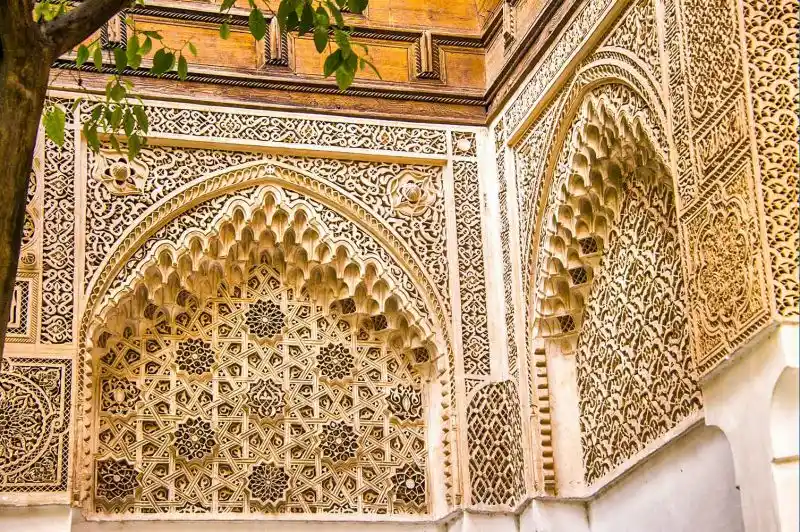
Planning Your Visit to the Bahia Palace
Discerning travelers seeking to unlock the full splendor of this architectural treasure will find that strategic timing and thoughtful preparation elevate the Bahia Palace experience from merely impressive to utterly unforgettable.
Best times to visit and avoid crowds
The palace reveals its most intimate secrets during the tranquil early morning hours when gates first open, or during late afternoon when golden light transforms the ancient stones and gardens reach their peak serenity. October through April present the most favorable climate conditions for unhurried exploration of the palace's intricate details. Photography enthusiasts discover pure magic around 3:00 PM, when afternoon sunlight creates spectacular prismatic displays through the palace's pioneering stained-glass installations. Weekday visits consistently offer a more contemplative atmosphere, allowing deeper appreciation of the architectural nuances that weekend crowds often obscure.
Ticket prices and opening hours
Bahia Palace opens its doors to curious minds daily between 8:00 AM and 5:00 PM. Current admission stands at approximately 70 dirhams (roughly $7.50) for international visitors. Residents benefit from thoughtful pricing structures. Moroccan nationals pay just 30 dirhams for adults, while children aged 7-13 enter for 10 dirhams. The palace demonstrates remarkable accessibility, offering complimentary admission to individuals with reduced mobility and Moroccan citizens every Friday, plus all national and religious holidays.
Nearby attractions in Marrakech
Bahia Palace occupies a strategic position within Marrakech's historic medina, situated merely 900 meters southeast of the legendary Jemaa el-Fnaa. This prime location creates exceptional opportunities for architectural enthusiasts to craft rich cultural itineraries. The renowned Saadian Tombs lie just 766 meters away, while the magnificent ruins of El Badi Palace await exploration at 480 meters distance. The exquisite Dar Si Said museum beckons from 248 meters, and the vibrant, aromatic souks pulse with life at 734 meters.
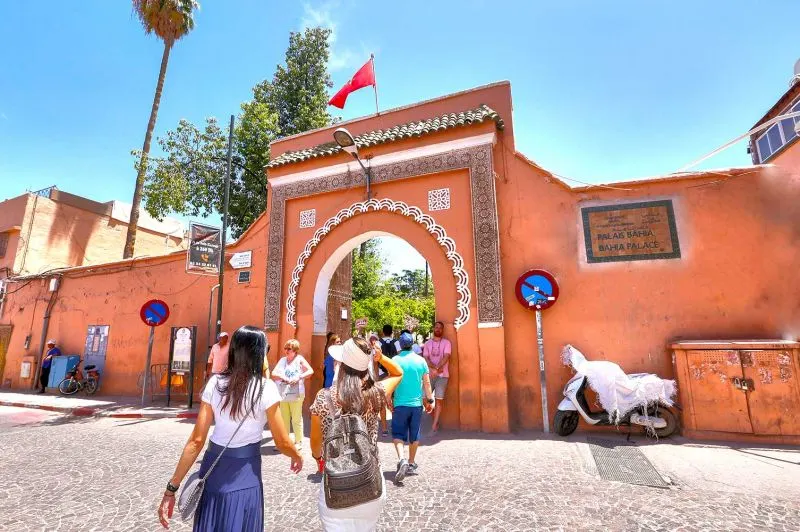
Conclusion
Bahia Palace represents far more than a mere architectural achievement; it stands as Morocco's most eloquent narrator of power, artistry, and cultural evolution. This remarkable complex demonstrates how personal ambition can manifest into enduring cultural heritage, creating spaces that continue to educate and inspire generations of visitors from around the world.
The palace's greatest lesson lies not solely within its ornate chambers or marble courtyards, but in how it embodies the intersection of human stories with architectural innovation. Si Moussa and Ba Ahmed's extraordinary journey from slavery to supreme power finds physical expression in every carefully crafted surface, transforming personal triumph into shared cultural treasure. Their vision created something unprecedented: a residence that functioned simultaneously as a political center, a family sanctuary, and an artistic showcase.
What distinguishes the Bahia Palace from Morocco's other historic monuments is its ability to make the past feel remarkably present. The sensory richness of orange-scented gardens, the interplay of natural light with handcrafted surfaces, and the intimate scale of interconnected rooms create an immersive experience that transcends typical monument visits. Visitors don't simply observe history here; they step directly into the daily rhythms of 19th-century Moroccan aristocracy.
This architectural marvel has rightfully earned its position as Morocco's premier heritage destination, drawing hundreds of thousands of visitors annually who seek authentic encounters with North African culture. The palace succeeds because it offers multiple layers of discovery, artistic techniques that revolutionized regional architecture, social insights into elite Moroccan society, and aesthetic experiences that engage all the senses.
Bahia Palace ultimately serves as Morocco's most accessible gateway to understanding how culture, politics, and artistry interweave to create lasting legacies. Each visit reveals new details, new perspectives, and new appreciation for the extraordinary vision that transformed royal ambition into one of North Africa's most treasured cultural monuments.
FAQs
Q1. What is the historical significance of the Bahia Palace?
Bahia Palace was built in the 19th century by Si Moussa, a former slave who became Grand Vizier, and later expanded by his son Ba Ahmed. It symbolizes the rise to power of these influential figures and reflects the opulent lifestyle of Morocco's elite during that era.
Q2. What are some unique architectural features of the Bahia Palace?
The palace is known for its single-level design, intricate marquetry and plasterwork, and the integration of gardens as functional living spaces. It's also notable for being the first building in North Africa to use stained glass as a decorative element.
Q3. How large is the Bahia Palace and how much of it can visitors see?
The Bahia Palace spans about eight hectares, with around 150 rooms. However, only a portion is open to the public, covering approximately 8,000 square meters of ornate architecture and gardens.
Q4. What's the best time to visit the Bahia Palace?
For a less crowded experience, it's best to visit early in the morning or late afternoon. The most magical time for photography is around 3:00 PM when the afternoon sun creates beautiful effects through the stained-glass windows.
Q5. Are there any nearby attractions to visit after the Bahia Palace?
Yes, the palace is conveniently located in Marrakech's medina. Within walking distance, you can find the Saadian Tombs, El Badi Palace, Dar Si Said, and the colorful souks, all less than a kilometer away.














